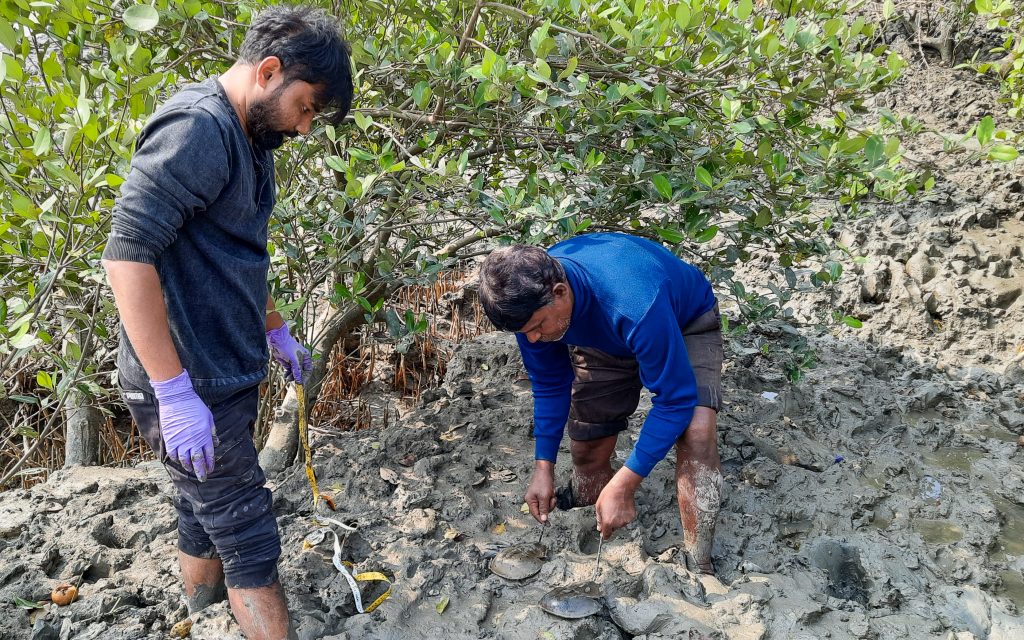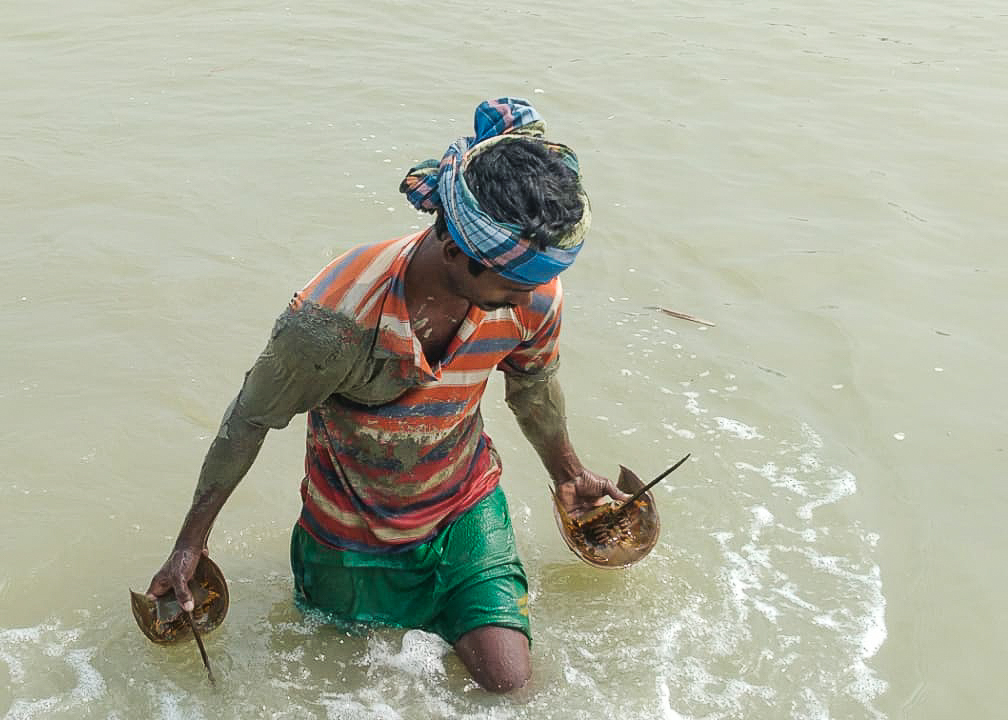Horseshoe crabs: ancient marvels facing modern threats
The horseshoe crab has been around for more than 450 million years. It has survived three mass extinctions, including the Cretaceous–Tertiary extinction event 65 million years ago, when more than 70 percent of all life forms, including dinosaurs, were wiped off the planet. Apart from being one of the oldest, the horseshoe crab is also among the most resilient of animals. Yet, despite being around for so long, not a lot is known about these living fossils.
Contrary to its name, the horseshoe crab is not a true crab nor a crustacean; it is, in fact, closely related to spiders and scorpions. With ten eyes situated all along its protective shell, five pairs of legs hidden underneath the carapace, and a protruding spike for a tail, it is a creature that is a perfect ensemble of prehistory. Horseshoe crabs play a crucial role in the coastal food web. Shorebirds, most of which are migratory, depend on their eggs as a food source, as do several species of fish and invertebrates. The horseshoe crab’s blue-coloured blood is an important component of medical research and the health industry, yet its own survival faces an uncertain future.

Horshoe Crab in Balasore | Photograph by Dr. Biswajeet Panda
Horseshoe crabs visit the intertidal mudflats only for the purpose of breeding, spending their first year of life along coastal habitats and shallow waters, before moving deeper into the ocean. Feasting on clams, worms and algae, horseshoe crabs will only begin breeding after they reach adulthood at about 10 years of age. For the next decade, they will return back to the beach every summer, to reproduce. Being largely understudied animals, their return to the beach is the only part of their lifecycle that we have information about.
An eye for survival
The horseshoe crab is nocturnal and possesses some unique adaptations. Cruising along the shallow coastal seabed, it uses moonlight to its favour—to both forage and spawn its next generation. It has a pair of large compound eyes seated laterally, each with 1000 photoreceptors, as its primary visuals. Five more super-eyes, located on top of the shell, detect the ultraviolet spectrum, allowing the animal to navigate its surroundings on dark nights. Two more eyes on the underside, close to the mouth, help maintain a stable orientation against the flowing current. Lastly, an eye situated on the tail helps keep track of the day and night cycle.
The animal not only brings variety into visual engineering, but also possesses a well-defined circadian clock in its brain. The eyes of the horseshoe crab are the reason we have been able to extensively study our own vision.
Double-edged sword
Nevertheless, it was not just the vision of the crab that humans eyed. The baby-blue-coloured blood of horseshoe crabs has been harvested since the early 1600s—the colonial times in modern USA—initially to be used as “cancerine fertilisers” and later as a test for bacterial contamination in drugs. An important discovery was made in the 1950s, when Frederick Bang found that horseshoe crab blood contained a chemical called Limulus Amebocyte Lysate (LAL).
This compound came to be widely used in the pharmaceutical industry to test for the presence of any bacterial contaminants, because it helped identify endotoxins even at concentrations as low as one part per trillion. The moment LAL comes in contact with any contaminant, the solution turns into a ‘gel’, immobilising the bacteria within the gel. The LAL test is instantaneous and simple, and creates a sample that remains stable for weeks, even at room temperature, and it replaced unethical testing on rabbits and mice. The test went on to become an important step in the approval of any drug, surgical implant and prosthetic device hoping to get the Food and Drug Administration’s approval. The horseshoe crab’s blood has helped deliver insulin as well as COVID-19 vaccines.
On account of the presence of this important chemical compound, horseshoe crab blood became one of the most expensive liquids on earth. According to Business Insider, the price of the blood is valued at $60,000 per gallon, and the demand is growing. However, this has led to the overexploitation of the species. About 30 percent of all horseshoe crabs collected for drawing blood die in the laboratory, and those that are released have been reported to show diminished chances of survival in the wild.
For the horseshoe crab, this unique chemical defence evolved to help it survive its bacteria-rich habitats. The moment the crab’s blood cells detect invaders, they release LAL, thus creating a gel-like physical barrier that immobilises the bacteria. But, what was supposed to protect the animal is now the reason for its demise. In the 1970s, the high demand for LAL led to the start of a severe decline in the horseshoe crab population globally. Despite existing regulations, horseshoe crabs are poached in the thousands to meet the demands of the growing pharmaceutical industry.

Horshoe Crab (Tachypleus gigas) from Balasore | Photograph by Dr. Biswajeet Panda
Emerging threats in India
Apart from the demand from pharmaceutical companies, horseshoe crabs are also increasingly threatened by pollution and habitat destruction. Delaware Bay in the US, which has the largest population of horseshoe crabs, saw a decline from about 1.24 million Atlantic horseshoe crabs (Limulus polyphemus) in 1990 to about 334,000 by the early 2000s.
Among the four species of horseshoe crabs, two are found in India—the mangrove horseshoe crab (Carcinoscorpius rotundicauda) and the Indo-Pacific horseshoe crab (Tachypleus gigas). A recent study revealed a 64.7 percent decline in the population of mangrove horseshoe crabs and a 72.2 percent decline in the population of Indo-Pacific horseshoe crabs between 2000 and 2010. The fourth and largest species, the Japanese horseshoe crab (Tachypleus tridentatus), too is in a similar situation.
In India, there are additional threats facing the two species of horseshoe crabs. According to Prof. B.C. Chowdhury, a member of the IUCN-SSC Marine Turtle Specialist Group and advisor to the Wildlife Trust of India’s (WTI) marine projects, the primary reason for the decline of horseshoe crabs in the country is the destructive fishing practices prevalent along the eastern coast, which is home to the horseshoe crabs. Although not targeted, horseshoe crabs form a substantial part of the bycatch along the intertidal flats. Plucking them out of the nets is not easy and causes severe skeletal damage to the animals. Those that are plucked out whole are left scattered on the beach to perish. Moreover, since these are hard-shelled animals, fishermen also blame them for reduced fishing productivity due to the damage caused to their nets by the shells.
Bichitrapur beach located in a mangrove forest reserve in the Balasore district of Odisha used to be an important feeding and spawning ground for the Indo-Pacific horseshoe crab, but sightings have drastically reduced over the years. Dr. Biswajeet Panda, who is conducting a study on horseshoe crabs along the beaches of Balasore, suggests that poaching might be a major threat to the population. This despite both species in India being protected under Schedule II of the Wildlife (Protection) Act, 1972, where illegal collection/hunting can attract a jail term of three years, a fine of up to INR 100,000 or both.
Satyajit Maity, a local fisherman from Dhublagadi village, remembers growing up seeing and playing with horseshoe crabs, saying they have now “vanished” from the coasts of Bichitrapur. Although the exact nature of trade is not known—with traders from places farther away contacting local fishermen to collect the animals and the specifics are kept under wraps—he confirms that it does exist and could be one of the reasons for the decline in numbers. According to Maity, a good-sized adult can sell anywhere between INR 800–1,000 (US$ 9.61–12.01).

Assessment of Horseshoe Crab population in Sundarbans | Photo by Dr Punyasloke Bhadury
There is also increased pressure from other anthropogenic activities. Increased construction along the beaches like Digha and Sagar Islands in the Indian state of West Bengal has led to a change in the texture and composition of the sand and sediment. This has also led to a shift in the congregation sites of the crabs over the past decade. According to Dr. Panda, more than 400 horseshoe crabs (across both species) were sampled in surveys that date back to the late 1980s. However, during a recent survey, they found less than 10. This tragically illustrates the severity of the decline.
Physiochemical changes in the habitat due to coastal erosion, industrial effluents and increased human activity have led to the loss of long-time spawning grounds for the species. Dr. Punyashloke Bhadury from IISER-Kolkata says that the population of the Indo-Pacific horseshoe crab is severely threatened by changing river systems. Faulty barrage management, like the one in Mahanadi River, has led to less clay sediment flowing into the river mouths compared to what it was a decade ago. The river courses have changed, the water volume has decreased and thus, the nutrient cycle that the crabs depend upon is affected. In addition, increasing amounts of wastewater being dumped into the sea without adequate treatment has led to an increase in nitrogen levels, thereby changing the physiochemical composition of the feeding grounds for the worse.
The aftermath of Cyclone Amphan
In May 2020, Cyclone Amphan caused colossal damage to the coastal habitat along the Bay of Bengal in India. Sagar Islands, a prime breeding ground for these crabs, was one of the most severely affected areas. Huge patches of mangrove and the adjacent mudflats were damaged. The high winds also brought in debris that changed the sediment composition of the banks.
Dr. Bhadury and his team, supported by WTI’s Rapid Action Project grant, led a cleaning drive while simultaneously assessing the sediment texture of the mudflats. With the help of local volunteers from the fishing community, some of these habitats were restored, debris and marine macroplastics were removed, and several horseshoe crabs were rescued and rehabilitated. More than 35 crabs, including gravid females, were rescued alive from ghost nets and released as part of the drive.

Conservation of Horseshoe crabs in Sundarban Delta | Photograph by Dr. Punyashloke Bhaduri
Dr. Bhadury’s project has helped generate baseline information on horseshoe crabs and their habitats, while paving the way for the first coordinated rescue and release initiative for the species in this landscape. He now calls for urgent collaborative efforts involving state Forest Departments and governments, and NGOs to map the breeding sites and record the status of habitats of horseshoe crabs across their range. According to him, future conservation plans for this species need to ensure the long-term improvement of their habitats by conducting science-based mangrove plantations and sustainable management of debris, with a special focus on the involvement of fishermen communities.
Straddling both water and land, horseshoe crabs are a symbol of adaptability and resourcefulness in several cultures across the globe. It would be a shame if this prehistoric creature that survived mass extinctions is lost to anthropogenic exploitation. The horseshoe crab is a stark reminder of why we should revisit our existing relationship with nature, and rethink our overuse of its precious resources.
The article was first published on Current Conservation Magazine on June 24th, 2024.
by Madhumay Mallik









